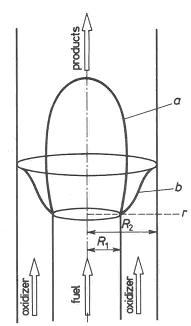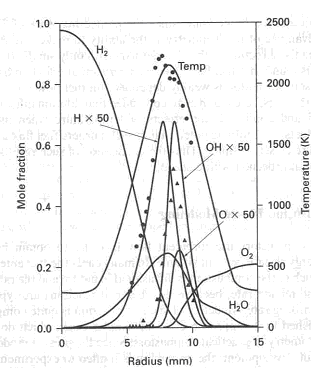
|
BRHS /
Burke-Schumann flame structure Figure 1. The shapes of laminar diffusion flame under: a) over- and b) underventilated situations [Chomiak 1990] Diffusion flames are when the fuel and oxidizer are physically separate so that the energy release rate is limited primarily by the mixing process. There is no fundamental flame speed as in the case of premixed flames. Chemical kinetics plays a secondary role. Diffusion flames occur with flowing gases, with vaporization of liquid fuels and with devolatilization of solid fuels. It follows from the experimental data that the reaction zone in diffusion flames is thin, just as in premixed flames, and can be treated as flame front. The flame front is located where the stream of the original components flowing into the combustion zone meet in a stoichiometric ratio. A classical example of a laminar diffusion flame, which was first described quantitatively by Burke and Shumann, is provided by a system in which fuel and air flow with the same linear flow velocity in coaxial cylindrical tubes. The observed shapes of diffusion flames may be divided into two classes. If the ratio of the dust radii rs top rj is such that more air is available than what is required for complete combustion, than an overventilated flame is formed and the flame boundary converges to the cylinder axis. On the other hand, if the air supply is insufficient for complete burning, than underventilated flame is produced in which the flame surface expands to the outer tube wall (Figure 1). The flame shapes and flame heights calculated from Burke and Shumann theory are in good agreement with experiments. Figure 2 shows some of the computed profiles and experimental data points.  Figure 2. Concentration and temperature profiles in a hydrogen-air diffusion flame at 2 cm above fuel inlet; the hydrogen tube had a 5 cm radius; circles are measured temperatures and triangles are measured OH concentrations [Fukutani et al. 1991] Chomiak J. (1990) Combustion. A Study in Theory, Fact and Application. Gordon and Breach Science Publishers << Strategies in the prevention of detonation | Content | Turbulent diffusion jet flame: flame structure, specific features; scales and combustion regimes in turbulent non-premixed combustion >> |